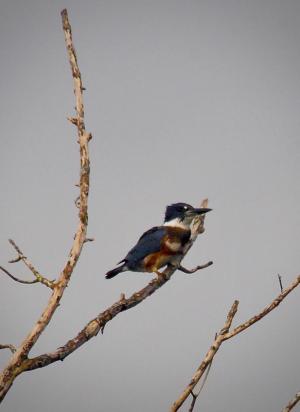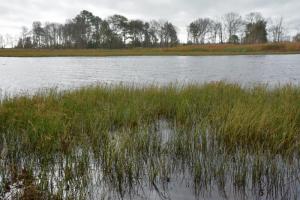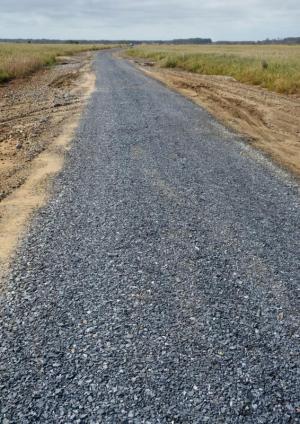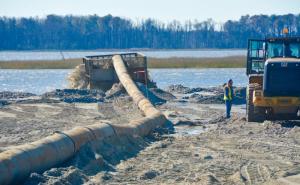It took a year and $38 million, but work to restore the shoreline and the marsh behind it at Prime Hook National Wildlife Refuge is largely complete. Now it's time for Mother Nature to work her magic to reclaim more than 1,000 acres of marsh.
Refuge officials say that process should take three to five years if the current trend is an indication of the future, said Al Rizzo, project leader for the Coastal Delaware National Wildlife Refuge Complex, which also includes Bombay Hook.
Large sections of spartina grass have already starting growing in the northern section of the most-damaged area of the refuge. Other grasses have started to take root in the mud flats created by a massive dredging operation at the refuge located near Milton along the Delaware Bay.
With a short growing season and a summer drought no one thought much grass would grow, said Bart Wilson, project manager with the U.S. Fish and Wildlife Service. “All of the vegetation we have this year is a bonus,” he said.
“It's an open canvas right now and a great nursery ground,” said Art Coppolla, refuge manager.
• Four substantial breaches have been filled in, and nearly 9,000 feet of shoreline has been replenished with 1.4 million cubic yards of Delaware Bay sand.
• The dune has been restored to a height of 9 feet with a 100- to 600-foot-wide back barrier platform between the dune line and marsh.
• More than 500,000 plugs of beach grass and 10,000 feet of fencing have been added to stabilize the dune and back barrier.
• More than 25 miles of channels have been dredged in the marsh to restore the refuge to a tidal system and manmade water-control structures have been removed.
• The channels will allow free flow of water from the Broadkill River in the south and Slaughter Canal and Prime Hook Creek in the north. It's that water moving through the channels that will provide the foundation for marsh restoration. Mud flats have been exposed, allowing grasses to grow.
• The refuge will revert back to a saltwater marsh with some areas of freshwater wetlands.
• During the summer, more than 1,000 acres of 16 grass species was planted by aerial seeding.
• Fish such as white perch and bluefish are finding habitat in new deep-water channels.
• Saltwater is no longer flooding farm fields adjacent to the refuge.
Piping plovers find home on beach
Damage to the refuge took place over several years, aggravated by a series of storms, but restoration has taken only a year, with work concentrated in the Unit 2 and Unit 3 impoundments. The refuge is organized into four units, which are bounded to the north by Fowler Beach Road and to the south by Route 16. The two units include more than 5,000 acres of the 10,144-acre refuge.
The project is one of the largest marsh restoration projects ever attempted on the East Coast.
"The good news is the biological response has been phenomenal," said Al Rizzo,
Once the beach restoration project started, it didn't take long for piping plovers to establish a nest in the coarse sand on the new beachfront.
"It's the first documented nest on Prime Hook," Rizzo said. "This highlights our primary focus to restore habitat in the refuge." Rizzo said to protect the nest, the beach was closed. It has remained closed as refuge staff work to complete parking and and a walking access area to Fowler Beach.
Other shorebirds – including oyster catchers and least terns – have returned to the refuge, Rizzo said. "And this year's horseshoe crab count exceeded all expectations," he said.
Marsh destroyed by saltwater intrusion
Nearly all of the marsh in Unit 2 was destroyed by saltwater intrusion from the Delaware Bay. A series of storms over the past eight years opened breaches along the coastline; Superstorm Sandy in November 2012 only exacerbated the damage.
Thousands of acres of what used to be freshwater marsh were changed to open water, drowning out marsh plants. Restoring the marsh also protects the small community of Primehook Beach, which borders the refuge.
Rizzo said the new beach profile allows tidal surges to roll over the beach and dune. The replenished back barrier along the dune line protects both the beach and the dune. It survived its first test when Jonas hit the coastline in January 2015.
New bridge on Prime Hook Road
In conjunction with the restoration project, DelDOT constructed a new $1.64 million bridge on Prime Hook Road. Water now flows under the bridge in the largest channel dug out as part of the project.
The design worked. Rizzo said during the Oct. 1-2 storm that brought up to 12 inches of rain to the area, Prime Hook Road did not flood. In the past, the road has been one of the first to flood in Sussex County.
DelDOT will also replace culverts under the road to allow better water flow during high and low tides. Rizzo said the two projects should alleviate most flooding problems that have plagued the road for years.
Rizzo said a restoration project underway north of the refuge at Mispillion Harbor is critical to maintaining proper water flow in the refuge. The $6.5 million Bayshore Initiative project includes beach replenishment and restoration of the harbor's stone dike.
“The marsh will be back. Just look at how much spartina grass has grown in less than one growing season,” Rizzo said.

































































